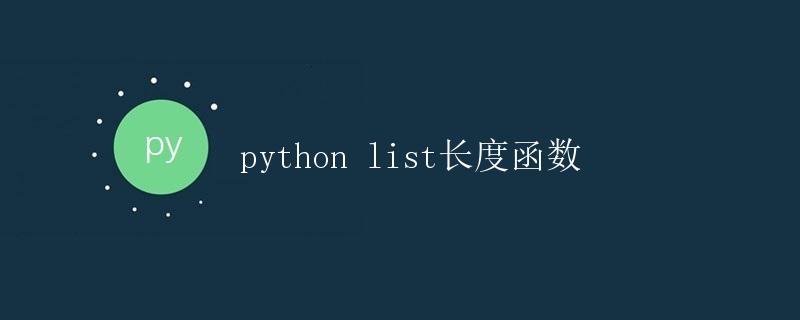Python list长度函数

在Python中,列表是一种非常常用的数据结构,可以用来存储一组有序的元素。在处理列表时,有时候我们会需要知道列表中元素的数量,也就是列表的长度。Python提供了一个内置函数len()来获取列表的长度,本文将详细介绍该函数的用法及示例。
len()函数概述
len()函数是Python内置的一个函数,用于返回一个对象的长度或者元素的个数。在传入一个列表时,它会返回列表中元素的数量。需要注意的是,len()函数可以应用于字符串、元组以及其他一些可迭代对象,但本文将主要关注其在列表中的应用。
len()函数的参数是一个序列(如列表、元组、字符串等),返回值是该序列中元素的数量。
len()函数的基本用法
以下是len()函数的基本用法:
my_list = [1, 2, 3, 4, 5]
length = len(my_list)
print("The length of the list is:", length)
在这个示例中,我们首先创建了一个包含5个整数的列表my_list,然后使用len()函数获取了列表的长度,并将结果打印输出。运行上述代码,输出为:
The length of the list is: 5
注意事项
在使用len()函数时,需要注意一些特殊情况:
- 如果传入的参数不是一个序列(如整数、浮点数、布尔值等),
len()函数会抛出TypeError异常。 - 对于嵌套列表,
len()函数会返回最外层列表的元素数量,而不会逐级计算内层列表的元素数量。 - 如果列表中的元素是可变对象(如列表、字典等),改变这些元素可能会影响列表的长度。
len()函数示例
示例1:计算列表中元素的数量
fruits = ['apple', 'banana', 'cherry', 'date']
num_fruits = len(fruits)
print("The number of fruits in the list is:", num_fruits)
运行结果:
The number of fruits in the list is: 4
示例2:处理空列表
empty_list = []
num_empty_list = len(empty_list)
print("The length of the empty list is:", num_empty_list)
运行结果:
The length of the empty list is: 0
示例3:嵌套列表
nested_list = [[1, 2, 3], [4, 5, 6], [7, 8, 9]]
num_nested_list = len(nested_list)
print("The number of elements in the nested list is:", num_nested_list)
运行结果:
The number of elements in the nested list is: 3
示例4:可变对象的影响
mutable_list = [1, [2, 3], 4]
num_mutable_list = len(mutable_list)
print("The number of elements in the mutable list is:", num_mutable_list)
mutable_list[1].append(5)
print("After adding an element to the inner list, the length of the mutable list is:", len(mutable_list))
运行结果:
The number of elements in the mutable list is: 3
After adding an element to the inner list, the length of the mutable list is: 3
在示例4中,我们看到虽然在内层列表中添加了一个新的元素,但len()函数仍然返回的是外层列表的元素数量。
总结
在Python中,len()函数是一个非常方便的工具,用来获取列表中元素的数量。通过本文的介绍,相信大家对该函数有了更深入的理解。在实际编程中,灵活运用len()函数可以提高代码的效率和可读性。
 极客笔记
极客笔记